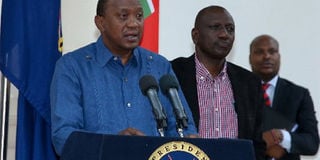Garissa could have been avoided if we had learned from past attacks

President Kenya briefs the nation on Garissa attack last week. The lesson the Kenyan Government can learn from the tragedies in Mpeketoni and Garissa is that when foreign governments with better intelligence than Kenya issue warnings about imminent threats, it should take them seriously.
What you need to know:
- In an interview last week, President Uhuru Kenyatta rubbished Britain’s advisory, adding that Kenya did not need British tourists.
- The building of a wall in Mandera may deter Somali terrorists from entering Kenya, but it will not diminish the threat posed by home-grown terrorists.
- It must also recruit more Somali-speaking officers in its security and intelligence-gathering networks.
In May last year, shortly after Chinese premier Li Keqiang made a high-profile visit to Kenya, Britain, France, and Australia issued travel advisories to their citizens, cautioning them against travelling to Kenya’s coastal region.
Having just signed a Sh327 billion loan to fund the standard gauge railway, the government insinuated then that the travel advisories were an envy-filled reaction to Kenya’s increasingly cosy relations with China. Barely a month after the travel advisories were issued, Al-Shabaab brutally killed more than 60 people in Mpeketoni.
Last week Britain and Australia cautioned their citizens against travelling to Kenya’s northeastern and coastal regions. Once again, on cue, the government responded by suggesting that the advisories were intended to cripple Kenya’s tourism sector and were a result of increasingly strained relations between Kenya and its former colonial master.
UHURU KENYATTA
In an interview last week, President Uhuru Kenyatta rubbished Britain’s advisory, adding that Kenya did not need British tourists (whom he said comprised mainly taxi drivers and the like) when it was preparing to receive high-profile dignitaries like President Barack Obama, who will be attending a conference in Nairobi in July. Barely a day after the President made these remarks, terrorists shot dead more than 140 university students in Garissa.
The President also questioned why there were no travel advisories against countries such as France, which have also suffered terrorist attacks.
He failed to acknowledge that when a terrorist attack takes place in a country like France, intelligence and security measures are stepped up to prevent future attacks. Kenya has failed to put in place such measures, as evidenced by the frequency and scale of attacks in the past two years.
The lesson the Kenyan Government can learn from the tragedies in Mpeketoni and Garissa is that when foreign governments with better intelligence than Kenya issue warnings about imminent threats, it should take them seriously. In fact, it should work closely with these governments to gather more details and intelligence on the threat and to mitigate them.
What all these attacks point to, once again, is the lack of an effective strategy to combat terrorism. The building of a wall in Mandera may deter Somali terrorists from entering Kenya, but it will not diminish the threat posed by home-grown terrorists.
It is clear that Al-Shabaab’s war has now been domesticated and is being waged not just by Somalis, but also by disenfranchised and radicalised Kenyans.
A recent report by the International Crisis Group says that Al-Shabaab is exploiting religious, ethnic, and socio-economic fault lines and grievances in Kenya to gain local recruits and to propagate its jihadist agenda.
Unfortunately, the Kenyan state and security forces are not doing enough to win the hearts and minds of poor, unemployed youth who are vulnerable to radicalisation.
On the contrary, they have treated vulnerable populations with heavy-handed brutality and arrogance. In 2013 security forces set ablaze the main market in Garissa, which effectively shut down the town’s economic lifeline.
RECRUIT SOMALIS
Last year it randomly rounded up and detained thousands of ethnic Somalis in Eastleigh.
If Kenya is to win the war against Al-Shabaab, it must be seen as a trustworthy, protective force, not one that unleashes terror on people who are already traumatised. It must also recruit more Somali-speaking officers in its security and intelligence-gathering networks.
Comparisons have been made between the Westgate attack and the one in Garissa in that both took place within large buildings and involved hostage-taking. However, in terms of local media coverage, the two incidents could not have been more different.
The first reporters on the ground in Garissa were not local journalists, but foreign correspondents from international news organisations, which led to the bizarre situation where local media organisations were using foreign media as their main source of information in the first hours of the attack.
And unlike the Westgate attack, there was very little real-time coverage of the unfolding tragedy. On the contrary, local television stations carried on with their regular programming as if nothing was happening. The other difference is that there have been no reports about looting, unlike Westgate, which was plundered.





